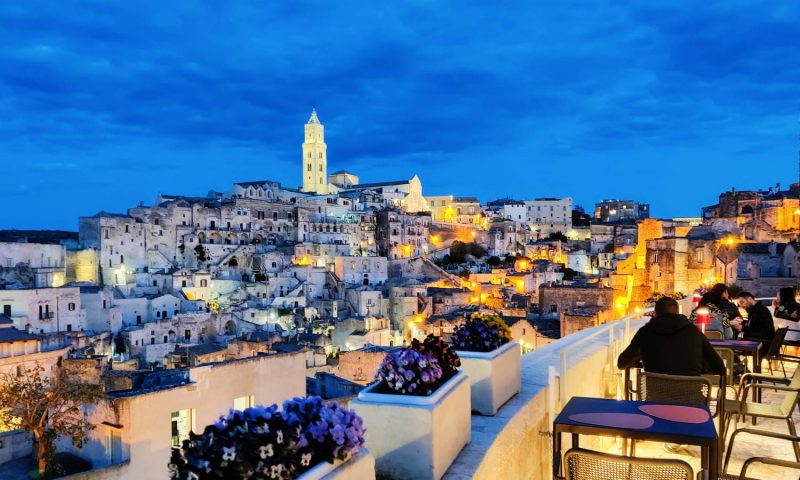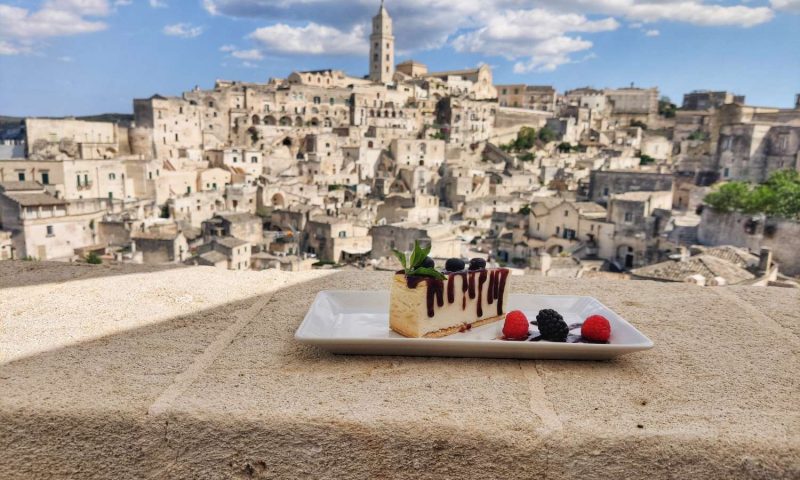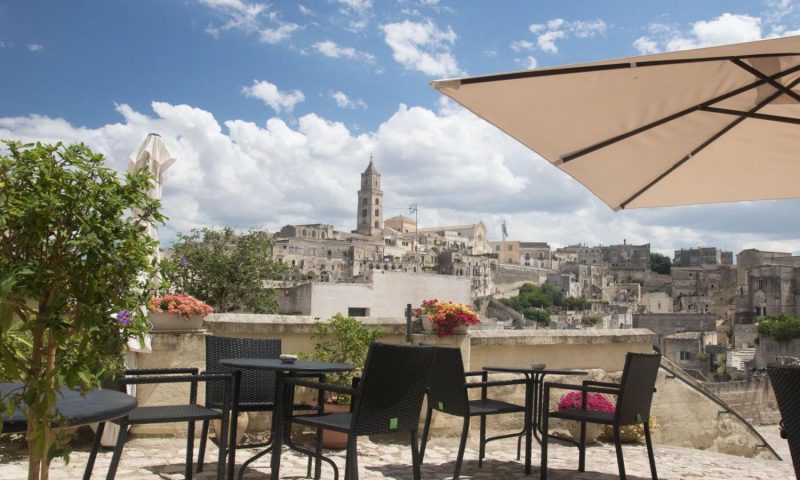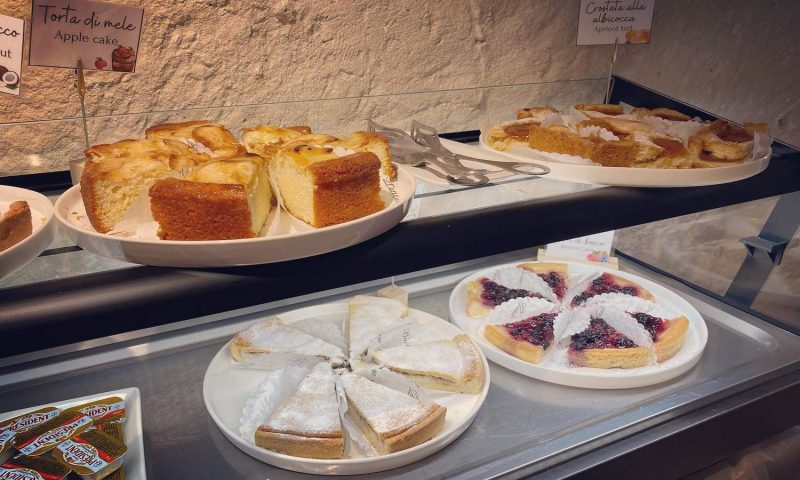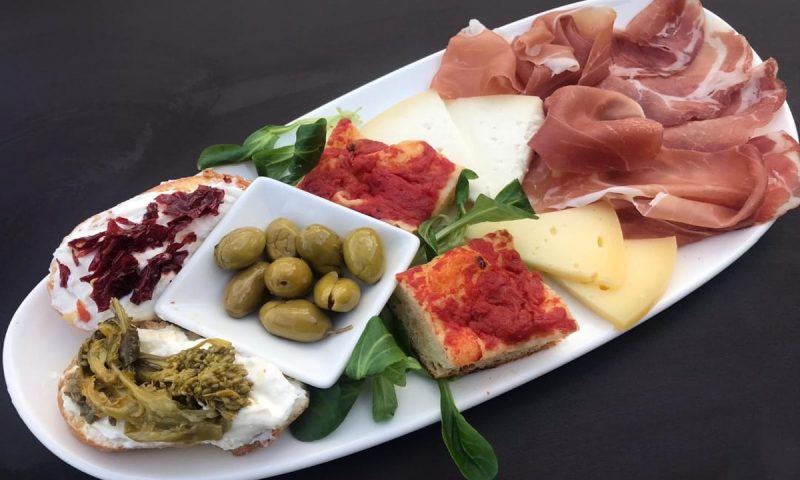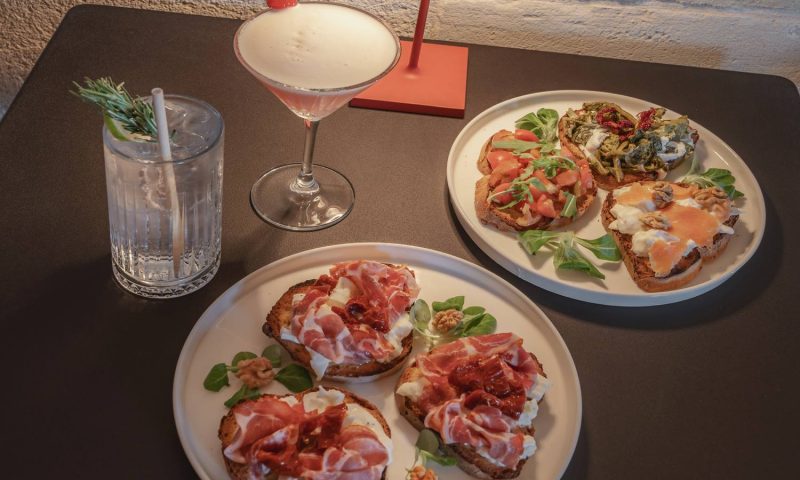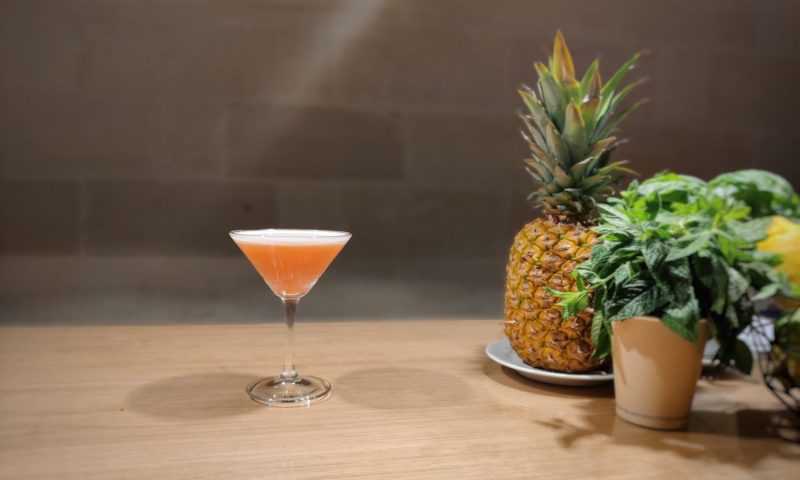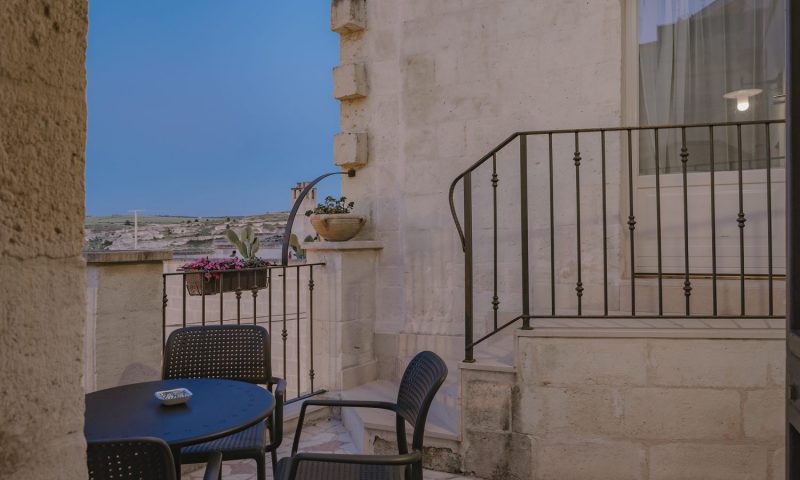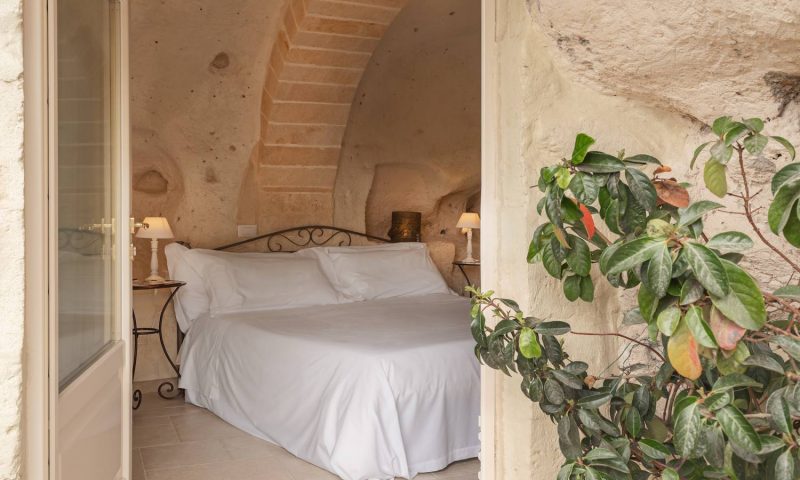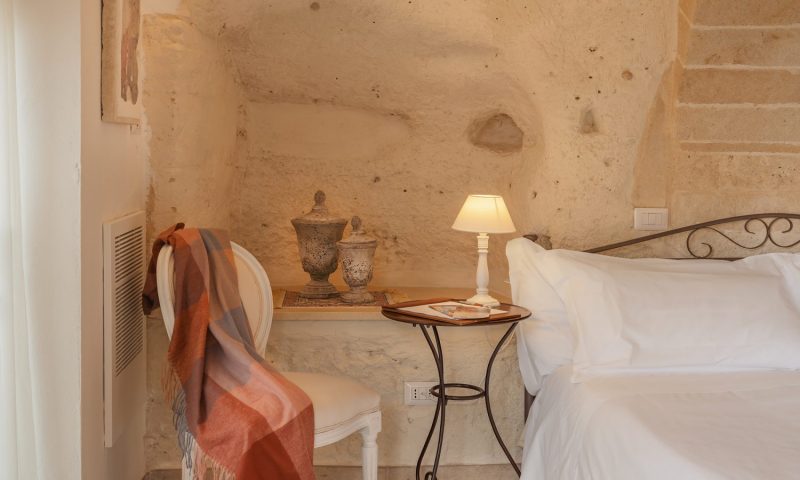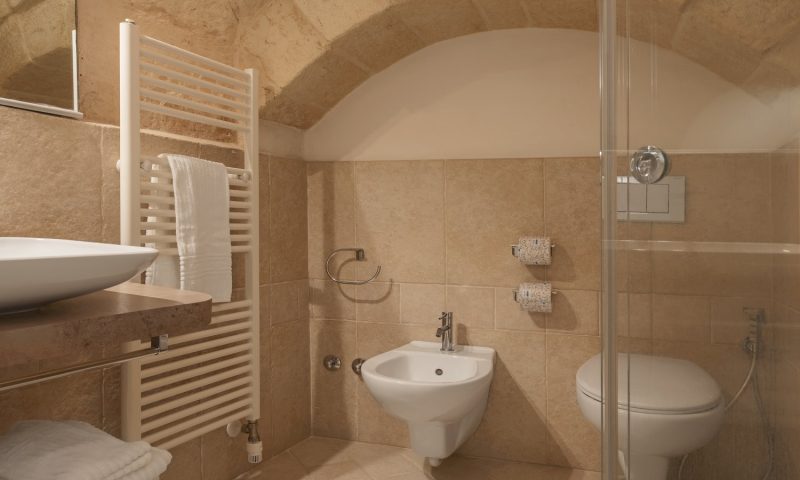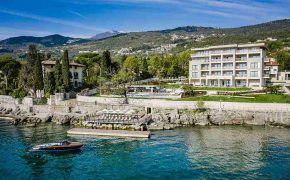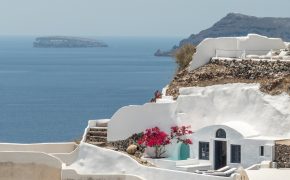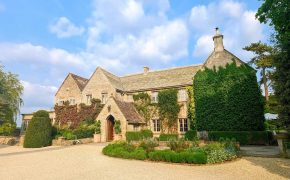In the heart of the historic Sassi in Matera (UNESCO world heritage), in a dominant and panoramic position rises from 1756 the Palazzo dei Abati, an ancient dwelling of the Chapter of the contiguous rock church of San Pietro Barisano, the largest in the city.
The heirs of the last abbot, who lived there until 1867, with a careful restoration work, have restored the ancient splendor of the structure, providing it with high levels of comfort and services, while respecting the uniqueness and originality of each of the five rooms: two in the cave, two built with decorated vaulted and one half excavated and half built.
From the delightful square of the church an important stone staircase leads to the large panoramic terrace with wide views of the Sassi and the massive Murgia plateau. From here, each room has independent access and is distinguished by a different history, style, ancient functions and typology.
THE HISTORY
The church of San Pietro Barisano was excavated in a rocky ridge, in the valley of the Sasso “Barisan”. In 1467, Pope Paul II gave the right of patronage of the church and its assets to Matthew Ciminelli: St. Peter Barisano became an “independent church” provided of the Chapter Ciminelli for the administration and it acquired the title of “Abbot”.
The churches were a typical figure of Southern Italy : they used to have the task of managing substantial real estate assets and production, were provided with a board of directors ( Chapter ) appointed by noble families (not by Curia) with rights of patronage, and the head of the chapter was placed the figure of the Abbot .
It was a sort of joint-stock company: the rents were in fact divided in proportion to the participants. The family Ciminelli has managed the church for over two centuries with many Abbots, followed by the
1775 – The appointment of the Abbot and the management of the church passed to the higher noble family in the city of Matera: the counts Gattini. These implemented a major renovation of the church , reconstructing the entire face, placing the elegant rose window and giving it a bell tower. Next to the church and in communication with this , the Palace of the Abbots was built by the counts Gattini with
1867 – The law n.3848 of the young Italian Government decreed the abolition of the accommodated churches and the confiscation of their assets. The church of St. Peter Barisan is stripped of 48 homes, 5 mills, 27 plots, 13 vineyards, 2 caves for the production of honey and wax, and the Palace of the Abbots.
Here lived the last Abbot : Rev. Nicola Scivizzero . The Palace , together with all the goods of the church , was auctioned by the State. The Abbot Don Scivizzero attended the Auction and managed to win it : he bought at auction the same building where he lived.
Of course, as abbot , he could not have children, so the whole structure was inherited by his sister Grazia Scivizzero . It was the year 1883. Since then, generation by generation, the Palace has been handed down as a legacy to the current owners.
But his life hadn’t been not always easy. At every transfer of property, the Palace was divided among the heirs, so in the twentieth century appeared to be inhabited by 10 families, one for each room of the hotel, including the rooms initially born as deposits , tanks and cellars. It was
In 1952 the ten families who lived there were easily marked with nicknames, as it was common at that time: Cudd’ngsset , Quaparraun , Bamm’n , Senza Nidd , Ui Momm , Martnas , Zannaun , Maiustr, Iongiacit , Czzlaun. In that year, the Parliament issued the law 619, decreeing the coercive evacuation of the Sassi .
The ten families who lived in the palace , like all the others who lived in the Sassi , had to leave their houses. All the people that used to live in the Sassi, they could have a new popular house for free if they gave up the property to the State, otherwise
2007 – Vita Maria Andrulli , grandson of Cudd ‘ ngsset family requested the State the permission to begin the work of restoration and the granting of state property neighbors, and the reconstruction of the Palace took place. The entire main floor , consisting of six rooms , is granted for 35 years in exchange for the restoration, which began
SUITE DELUXE – PIGNATIDD
Entirely excavated into the rock in the Middle Ages, this open-space Suite develops in length with 3 comfortable and functional spaces: as soon as you enter there is a living area with a spacious sofa and a relaxation corner with minibar; continuing, in a slightly higher area, you arrive in the sleeping area with the double bed, wardrobe area and TV with adjustable arm.
A glass door leads to the luxurious salle de bain with a large bathtub and a huge waterfall shower. In the bedroom there is a remotely adjustable window above the access door (visible in the last image).
It overlooks a shared panoramic terrace with comfortable armchairs to admire a breathtaking view that goes from the Sasso Barisano to the Civita with the beautiful Cathedral up to the Canyon Gravina and the Archaeological Park of the Rock Churches.
This environment, until the 1950s, was mainly a home, generally handed down from father to son; subsequently the Sassi were displaced and abandoned; “Pignatidd”, in fact, refers to the nickname in Matera dialect of the last inhabitants before the displacement of the Sassi wanted by the De Gasperi Law of 1952.
“Pignatidd” in English is untranslatable: it was a nickname, in dialect, which referred to the owner as he was a craftsman who manufactured the characteristic terracotta containers that were used for the “Pignata”: a typical dish, made with sheep meat, potatoes and vegetables, baked in the oven, precisely in the Pignata covered by a lid of leavened dough.
JUNIOR SUITE SENZA NIDD
Entirely excavated in the rock, it overlooks the large shared terrace with a nice view of the Sasso Barisano, the Civita and the beautiful Cathedral. The arches in tuff, the rock and the original fossils of shells (dating 2 millions years old) enhance the charm of staying in a cave with the latest comforts and services.
Excavated in the Middle Ages, it became the main storage of the Abbots of the adjacent Church, San Pietro Barisano, the biggest Rock Church of the Sassi. After the Abbots lost the property of the Palace, every room was assigned to a family.
The last family that lived here was named”Senza Nidd” and they used to live here until the 1950s, years of the evacuation of the Sassi area. The nickname Senza Nidd in dialect means “Without anything” as the head of the family was orphan and poor.
JUNIOR SUITE CUDD NGSSET
It has a terrace and a window overlooking the plateau of the Murgia with its Archeological Park of the Rock Churches and the Sasso Barisano. Built in 1794 with the first enlargement of the palace of the Abbots, has a decorated XVIII century vault, and the original terracotta floor.
It was the bedroom of the abbots of the biggest Rock Church of the Sassi: San Pietro Barisano, dating back to the XIII century. After the Abbots lost the property of the palace, it was shared among some families. From the beginnings of the XX century till the 1950s, before the displacement of the Sassi, it was the Andrulli family’s house, or so called “Cudd ngsset“ .
It is also the birthplace of the current owner of the hotel, Vita Maria: the nickname of Cudd ngsset, that in dialect means “Plastered Neck“, is refered to her grandfather that was an injured soldier of the First World War, since then he had to bring a rigid support at his neck.
JUNIOR SUITE SAPAUN
Unique environment, entirely carved into the rock 5 centuries ago, it is accessed from the large shared panoramic terrace that can be enjoyed comfortably seated on armchairs outside. The breathtaking panorama ranges from the Sasso Barisano to the Civita with the beautiful Cathedral up to the Canyon Gravina and the Archaeological Park of the Rupestrian Churches.
The exposed rock and marine fossils (dating back to 2 million years ago) offer the memorable experience of staying in a cave with the most modern comforts and services while respecting natural spaces and its history.
The bathroom has a wonderful shower wrapped in the rock, unique and unrepeatable. The room has a small window above the access door, which can be opened remotely by buttons (viewable in image number 9).
It was inhabited from generation to generation since Middle Ages, until the 1950s, years of the displacement of the Sassi: the last inhabitants were, in fact, the members of the family nicknamed “Sapaun” who lived there, in fact, until to the 50s. “Sapaun” which gives its name to the current room in Matera dialect means “soap” as it referred to the fact that the head of the family manufactured soap.
CRIALOSS PANORAMIC CAVE CAFE BISTROT
The view of the Sassi from the terrace is simply breathtaking! The tuff arches, the exposed rock and the shell fossils enhance the enchantment and charm of the elegant internal rooms carved into the rock.
The ideal place to sip your favorite drink while admiring the spectacle of the Sassi of Matera from our terrace. Let yourself be tempted by the creations of our barmen!
DISCOVER MATERA
From our hotel we recommend you to start right away with the church of San Pietro BARISANO, the biggest rocky church of the Sassi, as well as the only one with a frontdoor and a bell tower (added in the XVIII century, when the Palace of the Abbots was built together with). At the end of our little square there is also CASA CAVA, a former quarry where tuff bricks were extracted, today restored to Auditorium.
After Casa Cava turn on the right and always keep going upstairs and you will get to the so-called “Città al piano”, which is the center of Matera not belonging to the Sassi: we advise you to have a look at the Church of SAN GIOVANNI BATTISTA, the oldest church in the “Città al piano” dating back to the XIV century (free entrance).
After a few meters you will get to Piazza Vittorio Veneto, the main town square where you can admire a beautiful view of the Sasso Barisano and the Cathedral from the three arches, and you can look out on the Hypogeum: one Hypogeum is the PALOMBARO LUNGO, the biggest cistern dug in Europe, where there is the possibility to visit it with a guided tour of 30 minutes (3€) where you’ll ge to know everything about the system of collecting the rainy water (main reason why the Sassi of Matera have been chosen by UNESCO as World Heritage). You could also visit the other Hypogeum, behind the square, with a tour that lasts one hour, the so called Matera Sotterranea.
Follow Via delle Beccherie until Piazza Duomo, where you can go inside the Cathedral (free entrance), and admire the beautiful view of another part of the Sasso Barisano.
From Piazza Duomo, cross Piazza del Sedile, go to the baroque church of San Francesco di Assisi and to the Baroque Church of the Purgatory, unusual church for its frontdoor decorations representing skeletons, skulls and people in flames (in the Purgatory).
Keep walking along Via Ridola, reach Piazzetta Pascoli and from there enjoy the view of the Sasso Caveoso and of the Gravina. Go to Via Bruno Buozzi to immerse yourself in the Sasso Caveoso, where you can admire the beautiful Rock Church of Madonna dell’Idris.
Go towards the church of San Pietro Caveoso and pass under the arch on the right: here you’ll see Casa Grotta (a typical house in cave of a poor family before the evacuation of the Sassi in the 1950s when this area was called the Shame of Italy because of the bad conditions of living in caves without electricity, sewer and running water).
Keep going on the street along the canyon and you’ll see the Rock Church of Santa Lucia alle Malve and at the end the historical area of an early medieval cemetery. Go back to Piazza San Pietro Caveoso and continue on the panoramic road on the ravine Gravina, via Madonna delle Virtù, and then turn right to go up to Via D’Addozio that will lead you back to our hotel.
SECOND DAY
Start your day visiting the rocky churches of Madonna delle Virtù and San Nicola dei Greci, two frescoed cave wondered, one over the other, a monastery and old houses with tanks and troughs (in this period there is a contemporary art exhibition about the sculptures of Salvador Dalì).
We recommend you to spend the rest of the day visiting the Archaeological Park of the Rocky Churches(Parco Archeologico delle Chiese Rupestri), reachable by car in 15 minutes. The Archaeological Park of the Rocky Churches is a UNESCO World Heritage site since 1993 and it is a unique place in the world where architecture and nature mingle until they merge.
Here you can revive ten centuries of spirituality in over 150 rock churches, and you can also admire the most beautiful panorama of the Sassi of Matera, the river, the deep ravine Gravina and the movie location where Mel Gibson filmed the Crucifixion of Jesus in the film “The Passion of Christ” .
In the afternoon, we recommend you not to miss the beautiful and mystical Crypt of the Original Sin (Cripta del Peccato Originale) known as the Sistine Chapel of the rocky art, dating to the VIII-XIX centuries.
The crypt was the place of worship of a rural settlement from the Middle Age which included a small monastic community. The church is adorned with splendid frescos, of a high aesthetic and theological value. It’s reachable by car or by private transfer that we can arrange for you.
THIRD DAY
The third day we recommend you to deepen the reality of the Sassi and the history of the nearby area by visiting the Museums of the City such as: the National Archaeological Museum “Domenico Ridola” that will let you travel from the Paleolithic Age to the Middle Ages.
Museum of the Contemporary Sculpture (MUSMA), the only museum in the cave in the world and the main Italian museum dedicated to Sculpture, which tells the story of the Italian and International sculpture, from the late 1800s to today.
National Museum of Medieval and Modern Art of Basilicata, inside Palazzo Lanfranchi, a XVII century building, built as a seminary and later used as a high school, whose exhibition is divided into sections of Sacred Art, Collections and Contemporary Art. Downstairs there is the Levi room with the large painting “Lucania ’61” painted by Carlo Levi.
La Casa Ortega, designed to document the presence in Matera of the great Spanish artist José Ortega, and to facilitate the discovery and exploitation of the local craft tradition.
La Casa in Grotta, an opportunity to realize how the life of some excavated houses of Sasso Caveoso were before they had been abandoned for the evacuation, that took place for a Prime Minister Alcide De Gasperi law, in 1952 . The house is furnished with authentic furniture and tools of the time when it was inhabited, and there are several in the Sassi.
IONIAN COAST & MAGNA GREECE (45 minutes/1 hour by car)
Stretches of fine golden sand are combined with a crystalline sea that was crossed a time from the ancient ships of the Greeks and Romans. Metaponto, the heart of Magna Grecia where Pythagoras lived and died , preserves the remains of its National Archaeological Museum and the ruins of the houses and temples, like the Palatine Tables, the remains of the temple of Hera.
The area of Ancient Greece also pervades the nearby Policoro, the ancient Heraclea, with the acropolis of the city inside the archaeological site, the sacred spaces that refer to the cult of Dionysus and Demeter and the exhibits kept in the Museo Archeologico Nazionale della Siritide.
DOLOMITI LUCANE (1 hour by car)
Situated in the Apennines the Lucan Dolomites form the heart of the homonymous Regional Natural Park (which extends to the forests of Gallipoli Cognato). The small dolomites are called the the most famous trivenete mountains for the morphological similarity.
The birth of the mountain range, overlooking the central part of the Basento valley, dates back to 15 million years ago. The beautiful towns of Pietrapertosa and Castelmezzano offer the experience of the ANGEL FLIGHT (a steel cable suspended between the peaks of Castelmezzano and Pietrapertosa allows you to try out for a few minutes the thrill of the flight: a unique adventure in Italy but also in the World for the beauty of the landscape and for the maximum overflight height).
Pietrapertosa is the highest town in Basilicata and is part of the Club’s most beautiful little towns in Italy, which includes nearly 200 locations along the entire peninsula, and in which there is also Castelmezzano.
THE VULTURE (1 hour and a half by car)
The Vulture is an extinct volcano that has given life to a rich environmental heritage, where the places of natural type are related to the presence of forests, springs (water Lilia, Gaudianello and Sveva), sub-mountain streams and vineyards (which produce the wine Aglianico del Vulture).
The most charming places of this aerea are: Venosa, Melfi and the Monticchio lakes. Venosa is one of the 200 “most beautiful villages in Italy”: birthplace of the great Horace, one of the greatest poets of the Roman era and the cradle of an artistic heritage of priceless beauty, such as the Abbey of the Holy Trinity, the Roman Archeological Park, the Castle of Pirro del Balso, now the seat of the National Archaeological Museum, the Paleolithic site of Notarchirico and the Jewish Catacombs.
Melfi, a city dear to the Normans and to Frederick II (in Melfi he issued the “Constitutiones Augustales”, the largest legislative work of the Middle Ages), was built around the imposing castle which now houses the National Archaeological Museum (with ancient objects from the VII c. BC to the XVII century: the most important is the Sarcophagus of Rapolla, a magnificent funerary monument from the Roman period).
Finally the Monticchio Lakes, located at the south western aquifer of Mount Vulture, occupy the craters of the old volcano. Just above the lakes, there is the Abbey of San Michele Arcangelo that was built in the VIII century A.D., around a cave inhabited by Byzantine monks.
